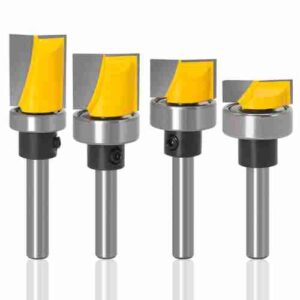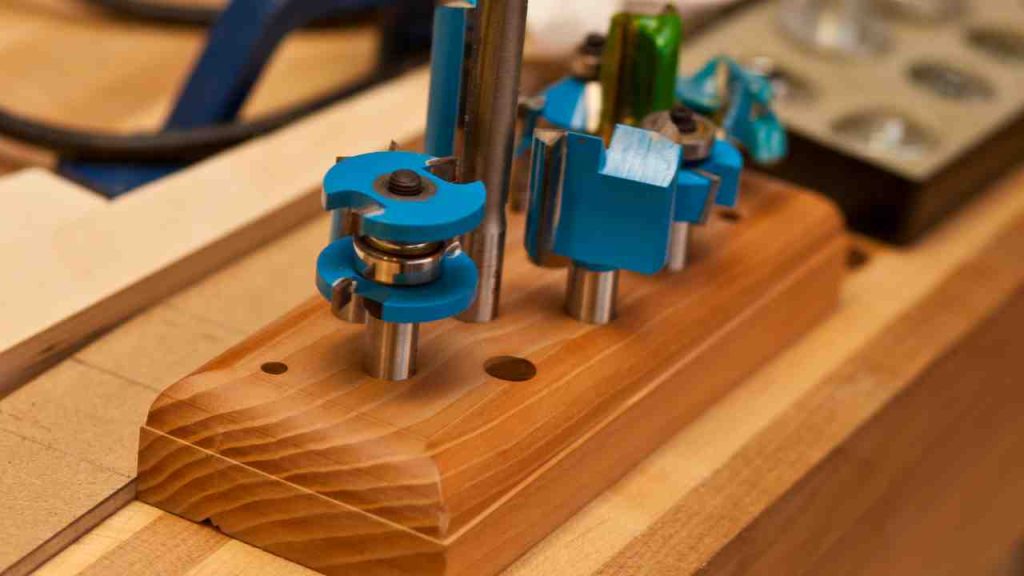If you’re a DIY enthusiast or professional woodworker, you’re familiar with router bits and drill presses. While these tools are essential for woodworking projects, they are not interchangeable and serve different purposes. Attempting to use a router bit in a drill press can be dangerous and potentially damaging to both the tool and the user.
In this blog post, we’ll explore the compatibility of router bits and drill presses, discuss the risks of using a router bit in a drill press, and provide alternative tools and techniques for achieving similar results.
Whether you’re a seasoned woodworker or just starting, it’s important to understand the differences between these two tools and how to use them safely and effectively. Let’s dive in and learn whether you can use a router bit in a drill press.
 What is a router bit?
What is a router bit?
A router bit is a cutting tool designed for use with a router, which is a powerful tool used in woodworking to hollow out, shape, and create decorative edges on wood and other materials. Router bits are typically made of high-speed steel or carbide and come in various shapes and sizes for different applications.
Router bits are designed to remove material quickly and precisely, allowing woodworkers to create intricate designs and shapes that would be difficult or impossible to achieve with traditional woodworking tools. They are used to create decorative edges, carve out channels, and create joinery for furniture and other woodworking projects.
Can you use a router bit in a drill press?
No, using a router bit in a drill press is not recommended. Drill presses are not designed to handle the high speed and torque required to spin a router bit, which can cause the bit to become unbalanced, vibrate, or even break. Additionally, drill presses lack the safety features, such as a plunge base or guards, necessary for safely using a router bit.
Using a router bit in a drill press can also be dangerous for the user. The high speed and torque of the drill press can cause the bit to seize or kick back, potentially causing injury or damage to the workpiece.
Differences between router bits and drill bits:
Router bits and drill bits are cutting tools used in woodworking, but they are designed for different purposes and have distinct differences.
The main difference between drill bits and router bits is that drill bits are designed for making holes, while router bits are designed for shaping and cutting. While drill bits can make small cuts in wood, they are not designed to create the intricate shapes and designs that router bits are capable of.
Additionally, router bits are designed to work with the high-speed rotation of a router, which provides the power and control necessary for precise cuts and shaping. Attempting to use a router bit in a drill press can be dangerous and potentially damaging to both the tool and the user.
Why are router bits not typically compatible with drill presses?
- Power: Router bits are designed to quickly remove a lot of material, which requires a lot of power. Routers are specifically designed to provide this power, with high-speed motors and variable speed controls to adjust the speed and torque to match the bit and material used. In contrast, drill presses are designed to provide more consistent, controlled drilling power with a limited speed and torque range.
- Speed: Router bits must spin high to remove material quickly and precisely. Drill presses typically have a limited speed range and may not provide enough speed or torque to use a router bit effectively. Attempting to use a router bit in a drill press can cause the bit to become unbalanced, vibrate excessively, or even break.
- Safety features: Routers typically have plunge bases and other safety features that prevent the bit from slipping or wobbling during use. Drill presses lack these features and may not provide enough support or control to prevent a router bit from becoming unbalanced or vibrating excessively, which can be dangerous for the user and damage the workpiece.
- Compatibility: Router bits are designed to work with routers, which have collets designed to hold the bit securely in place. Drill presses typically have a different type of chuck not designed to securely hold router bits, which can lead to slipping or other problems during use.
Alternatives to using a router bit in a drill press:
- Handheld router: A handheld router is a portable power tool that allows you to use router bits to cut and shape wood. Handheld routers are designed to provide the power, speed, and control necessary to use router bits effectively and safely. They come in various sizes and shapes, and some models have variable speed controls to adjust the speed and torque to match the type of bit and material being used.
- Trim router: A trim router is a smaller, handheld version designed for trimming and shaping smaller pieces of wood. Trim routers are ideal for making small cuts and intricate designs and are typically less expensive than larger routers.
- Rotary tool: A rotary tool, such as a Dremel tool, can be used with a router bit attachment to make cuts and shapes in wood. Rotary tools are small, handheld power tools that can be used for various tasks, including grinding, sanding, and cutting. They are ideal for working on small or intricate pieces of wood.
- Chisels and hand tools: Traditional hand tools such as chisels and hand planes may be a suitable alternative to using a router bit for some woodworking tasks. These tools require more skill and precision than power tools but can achieve similar results with practice and patience.
Frequently Asked Questions (FAQs)
1. Can I use a router bit with a regular drill?
No, using a router bit with a regular drill is not recommended. Router bits are designed to work with routers, which provide the necessary power, speed, and control for effective and safe use. Regular drills do not have the same capabilities and may cause the router bit to become unbalanced, vibrate, or break.
2. Are there any drill press attachments that can help me use router bits?
While there are some attachments available that claim to allow router bits to be used with drill presses, using such attachments is not recommended. Drill presses are not designed to handle the high speed and torque required by router bits, which can lead to dangerous situations and potential damage to both the tool and the user.
3. Can I use a drill bit in a router?
No, using a drill bit in a router is not recommended. Drill bits are designed for making holes, while routers and router bits are designed for shaping and cutting. Attempting to use a drill bit in a router can lead to dangerous situations and potential damage to both the tool and the user.
4. What is the main difference between a router and a drill press?
The main difference between a router and a drill press is their intended purpose and function. Routers are designed for shaping, cutting, and creating decorative edges on wood and other materials, while drill presses are designed for drilling holes with precision and control. Each tool has unique features and capabilities that make them suitable for their specific tasks.
5. Can I use a router bit in a drill press for small woodworking projects?
No, using a router bit in a drill press is not recommended, even for small woodworking projects. The differences in power, speed, and safety features between routers and drill presses make it unsafe and potentially damaging to use a router bit in a drill press. Instead, consider using alternative tools such as handheld routers, trim routers, rotary tools, or hand tools for small woodworking projects.
Final words:
In conclusion, using a router bit in a drill press is not recommended due to the differences in power, speed, and safety features between these two tools. Router bits are designed to work with routers, which provide the power, speed, and control necessary to use them effectively and safely. Attempting to use a router bit in a drill press can be dangerous and potentially damaging to both the tool and the user.

If you need to make cuts or shapes in wood that require a router bit, you can use alternative tools and techniques instead. Handheld routers, trim routers, rotary tools, and hand tools are all suitable alternatives that can achieve similar results with the necessary precision and control.
- Where are WEN drill presses made? - April 2, 2023
- Where are Rikon drill presses made? - April 1, 2023
- Where are Powermatic drill presses made? - April 1, 2023






